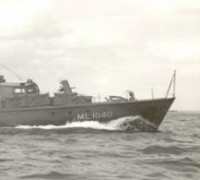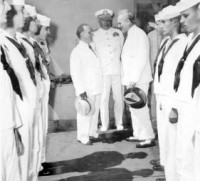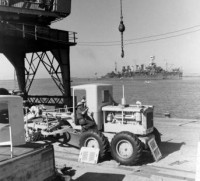MILITARY RELATIONS WITH BRAZIL BEFORE PEARL HARBOR - BRAZIL X USA MILITARY RELATIONS
4)APPROACH TO COLLABORATION
The approach to a new plan for wartime collaboration between the United States and Brazil began with the harmonious cooperation. between the two governments in the Rio de Janeiro Foreign Ministers Conference. On the eve of this meeting, the United States Army was not sanguine about the prospect for military cooperation with the Brazilian Army and Air Force. In a frank discussion on 3 January 1942 with Under Secretary of State Welles, General Marshall confessed that what worried him most was that the Brazilian military leaders had apparently changed their minds since 1939 and 1940 about wanting American assistance in the defense of the Brazilian bulge.
It was also pointed out to the Under Secretary that Brazil had promised in the 1940 Staff Agreement that if the United States was attacked by an Old World nation Brazil would permit American forces to use its air and naval bases and transit its territory, even though Brazil itself was not at war.
Mr. Welles insisted that the Brazilian Government and Army were loyally supporting the war effort of the United States, and that Brazil would break relations with the Axis nations and collaborate more closely in consequence of the Rio conference. A few days later the Under Secretary left for Rio de Janeiro, bearing with him a letter addressed by President Roosevelt to President Vargas containing these passages:
The public, of course, knows very little of the helpful and effective steps your Government has taken. I, on the other hand, have been kept fully informed by Mr. Welles and General Marshall and my other advisers of your magnificent cooperation, and I know that it goes far beyond any narrow interpretation of Hemisphere defense.
I appreciate from the bottom of my heart your generous attitude and assistance with regard to such matters as the ferry service to Africa and the naval and air patrols from your ports and airfields, to mention only a few. I did not fail to catch the import of your reference in your speech of December 31 to the delivery of "the material elements which we still lack." . . . I assure you that before long we shall be able to supply you with the equipment for which you have been waiting.
At the close of the Rio conference, on 28 January 1942, Brazil broke diplomatic relations with the Axis nations-a definite step toward military cooperation, though not one toward the entry of American security forces into Northeast Brazil. In Rio de Janeiro Under Secretary Welles thoroughly explored the problems in Brazilian-American defense collaboration in a series of conferences with President Vargas and with the Brazilian Minister of War and Army Chief of Staff.
He learned that the Brazilian Army leaders had objected to severance of diplomatic relations with the Axis nations because they believed that that meant war in the near future, and they felt Brazil's armed forces were in no condition to participate in the war. They were also concerned about the ambiguous position of Argentina.
In breaking relations, President Vargas had overruled the Army on that point, but he told Mr. Welles that stationing American ground combat forces in Brazil was out of the question for the time being. In the future it would be contingent upon the delivery of substantial quantities of military equipment that would permit Brazilian and American troops to engage in joint defense measures on an equal footing.President Vargas and Mr. Welles also developed a plan for a new organizational relationship between the Brazilian and American armed forces.
This involved, first of all, the replacement of General Miller and also of Lt. Col. Thomas D. White, the air attaché and Chief of the Military Air Mission. At Mr. Welles's urging, the Chief of Staff finally agreed to the recall of General Miller and Colonel White, though after their return to Washington General Marshall kept them on his planning staff for several months as informal advisers on Brazilian problems.
The second step in the new military relationship with Brazil was to be the establishment of a joint Brazilian-American defense commission. The commission, with headquarters in Washington, was to be staffed by high-ranking officers of the two nations. It was intended that the commission should become the main channel for all military communication and arrangement between the two nations.
General Marshall and Admiral Stark readily agreed to its establishment, and the Chief of Staff tentatively selected General Embick to serve as its senior Army member. The crux of a satisfactory defense arrangement with Brazil in early 1942-as it had been since the summer of 1939-was the ability of the United States to deliver munitions to the Brazilian Army and Air Force.
Under the lend-lease allocations in effect in January 1942, Brazil was to receive very few modern combat items before the fall of 1942. On 19 January Mr. Welles telephoned from Rio de Janeiro to President Roosevelt and asked the President to find out just what additional items the Army could release to Brazil in the near future. Mr. Roosevelt called General Marshall, and the Chief of Staff after consulting with his staff promised the immediate or early delivery of sixty-five light tanks and more than two thousand military vehicles of various types.
The President also inquired about more coast defense equipment, but General Marshall explained that the Brazilians did not want the obsolete weapons that were available. Neither did the Brazilians want all of the motor vehicles offered, but they did want a good -many more light tanks, and many items not offered-medium tanks, antiaircraft guns, antitank guns, and combat airplanes-items that the Army did not believe it could release for months to come.
The Brazilian Minister of Finance, Mr. Souza Costa, who came to Washington in early February, headed a group of Brazilian officials that pressed the Munitions Assignments Board and the War Department for a more favorable allocation of ground arms than that promised through President Roosevelt in January.
On 12 February the new War Department Munitions Assignments Committee (Ground) devoted its entire first meeting to a consideration of Brazilian requests, but the meeting ended with a decision that not much more could be done to increase or speed up deliveries to Brazil. The War Department at this time was terribly pressed by the demands of its own forces, and by the President's insistence that the terms of the Soviet protocol be fulfilled.
Furthermore, the British representative announced at the 12 February meeting that "if an increase were contemplated for Brazil or any other country, then an all-round reconsideration of the position of all of these countries would be necessary." Minister Costa met this situation with a statement on 17 February that he was completely dissatisfied with the Army's program for Brazil. Mr. Welles thereupon indicated that he intended to back the Brazilian demands for an enlarged program. This impasse was broken on 21 February, after the intercession of Mr. Hopkins.
The War and State Departments worked out a compromise that involved immediate delivery to Brazil of twenty additional light tanks and four 3-inch antiaircraft guns (taken out of the New York City harbor defenses for this purpose), and the drafting of a new lend-lease agreement that promised substantially larger munitions deliveries to Brazil in the future than had hitherto been planned.
On 3 March the United States and Brazil signed four agreements, three of which were concerned with a $100,000,000 credit to be advanced by the Export-Import Bank for the development of Brazilian production of strategic materials. The fourth was the new lend lease agreement, calling for the eventual delivery to Brazil of military equipment to the value of $200,000,000, or double the amount planned in 1941 and provided for in the Brazilian-American Lend-Lease Agreement of 1 October 1941.
Separately, but at the same time, the United States Army agreed that it would deliver certain items to Brazil before the end of 1942-one hundred medium tanks, more than two hundred light tanks, fifty combat airplanes, and a substantial number of antiaircraft and antitank guns.
The new lend-lease agreement and the accompanying pledges on deliveries in 1942 went far to satisfy the Brazilian quest for arms. The final impetus for a general Brazilian-American agreement on military collaboration came from the United States Army Air Forces. The rapidly mounting volume of military air traffic through Brazil made enlarged air base facilities and the services of Army mechanics and technicians mandatory.
On 15 February Brig. Gen. Robert Olds, commanding general of the Ferrying Command, personally presented his problems to President Roosevelt. He needed at least seven hundred and fifty additional men in Brazil, at the Belém, Natal, and Recife air bases, housing constructed for these men, and enlarged gasoline storage and other new base facilities.
He also wanted to obtain blanket clearance for Army-controlled flight operations through Brazil. The President told General Olds to ask Under Secretary of State Welles to submit these requests to the Brazilian Government. Mr. Welles declined to do so until the Brazilians had been satisfied on the score of lend-lease.
Thereupon, Secretary Stimson sent a personal appeal to the President, urging him to submit General Olds's requests directly to President Vargas, and adding as a postscript: I cannot tell you how important I think this Natal danger is. With the redoubled necessity of planes for Burma and China; with the French fleet moving in the Mediterranean; with subs in the Caribbean, we can't allow Brazil, who is not at war, to hold up our life line across Africa.
The Army accompanied Mr. Stimson's plea for action with the more generous proposal on early and future deliveries under lend-lease mentioned above, and the settlement of the lend-lease question a few days later paved the way for the submission of the Ferrying Command's requests to the Brazilian Government at the end of February. The Army had also proposed, once these requests were approved by Brazil, to send General Olds to Brazil to arrange the details of the Ferrying Command's new program.
That program received Brazil's quick sanction following the signature of the new lend-lease agreement on 3 March. On 9 March President Vargas approved "a wide reaching program for Northeast Brazil" that included the stationing of eight hundred additional United States Army maintenance personnel, new construction, and unrestricted flight privileges for Army aircraft.
Two days later the Brazilian Chiefs of Staff (Army, Air Force, and Navy) and Foreign Minister Aranha agreed among themselves on the draft of a Brazilian-American defense agreement to be proposed to the United States. Thus, when General Olds arrived in Brazil in mid-March, he found a situation and an attitude very different from that existing only a month before. Everything he wanted had already been granted or was now agreed to in conferences with Generals Dutra and Goes Monteiro, and with Brazilian Air Force authorities, including General Eduardo Gomes, the northern Brazil air commander.
General Olds invited General Gomes to return with him to the United States and promised to provide his air force with thirty modern bombers and thirty pursuit planes as soon as possible. The first increment of this reinforcement-six B-25's and six P-40's — was lined up at Bolling Field in Washington for General Gomes' inspection before he returned to Brazil.
After American crews flew these planes to Brazil in mid-April, there were still no more than one hundred fifty or so United States Army officers and enlisted men in Northeast Brazil; but they were firmly established there, and the way was open for enlarging their number in friendly cooperation with the armed forces of Brazil. In the meantime, the War Department had given its immediate and enthusiastic approval to the Brazilian draft of a defense agreement, the War Plans Division advising Mr. Welles, "we should lose no time in accepting it in principle."
To expedite the preparation of a final draft satisfactory to both nations, the Army proposed that conversations take place in Rio de Janeiro as soon as possible between delegations headed by Ambassador Caffery and Foreign Minister Aranha. The Army would be represented in the conversations by Air and Plans officers to be sent from Washington, and the Navy by the Chief of the Naval Mission in Rio.
Their purpose would be the conclusion of an agreement that would provide for the establishment of one or (as suggested by the Brazilians) two joint defense commissions and that would also fix basic policies for their guidance. Once established, these defense commissions could work out the specific joint defense measures deemed necessary. The Navy and State Departments concurred in the Army's proposals. Under Secretary Welles indorsed in particular the Army's hope that the defense commissions would produce "a joint war plan similar to ABC-1 now in effect between the United States and Great Britain."
The Brazilian Government promptly agreed to the proposed conversations in Rio de Janeiro to iron out the details of a defense agreement. To participate in the Rio conversations, the Army chose Col. Robert L. Walsh, then chief of the Air Intelligence staff, and Col. Henry A. Barber, Jr., of the Operations Division, who was General Ridgway's successor as the Army's principal Latin American planning officer.
These officers were told that the "primary result" of the Rio conversations "should be the creation of joint Defense Commissions in Washington and Rio for the purpose of preparing staff plans for the joint defense of Northeast Brazil," but that the conversations "should not involve the question of the stationing at present of large forces of American troops in Northeast Brazil."
The Army also warned its conferees against insisting on any changes in the draft agreement that "would in any way react unfavorably from a political standpoint so as to jeopardize the operations and functions of present Air Corps ferrying activities.” Colonels Walsh and Barber departed for Brazil on 5 April. By 18 April the Rio conversations had produced a text agreeable to the United States and Brazilian delegations, although matters beyond their control delayed its signature until 28 May 1942.
The new defense agreement provided for the establishment of two joint military commissions, one to be located in Washington and the other in Rio de Janeiro, and specified the general policies that were to guide the work of the commissions in terms very similar to those contained in the prewar staff agreement. The Washington commission was to draft a joint defense plan for Northeast Brazil and make such other recommendations for joint action as the terms of the agreement and the developing international situation made necessary.
The Rio commission was to act in association with the existing American Military and Naval Missions in improving the combat readiness of Brazilian forces. The negotiation of the Brazilian-American defense agreement of May 1942 coincided with a fundamental change in the United States Army's policy toward Brazil. Since 1939 its objective had been to put its own ground and air forces into Northeast Brazil to protect that vital area against overseas attack.
By June 1942 the Army had replaced this "original conception," as the Operations Division now called it, with the "present concept that Brazil and the United States will collaborate on the preparation of defense measures to be carried out by the Brazilian armed forces, with the full support of the United States armed forces for instruction and training in the use of the materiel which will be found necessary for us to supply."
Furthermore, the Army intended to make "every effort to maintain the flow of critical materiel established by the Lend-Lease program" for Brazi1. Actually, German submarine activity in the Caribbean area and off the Brazilian coast held up lend-lease deliveries until midsummer, and the first shipload of goods promised to Brazil in January and February did not reach Recife until 20 June. Thereafter, the flow of military equipment was steady and increasingly large.
The United States Army chose Maj. Gen. J. Garesche Ord as its representative on the joint Brazil-United States Defense Commission established in Washington, and the Brazilian Army chose General Leitao de Carvalho, who had commanded the ground forces in northern Brazil. The formal sessions of this commission, which functioned most harmoniously from the outset, began immediately after Brazil declared war on the European Axis in August, and its first recommendations were issued in September. The Rio commission was not organized until December 1942, after the Army had established a theater organization in Northeast Brazil.
Transcribed by Patrick Clancey – Hyper War Foundation.



